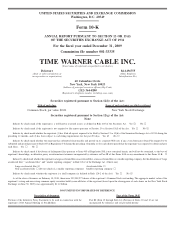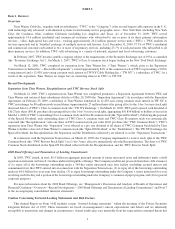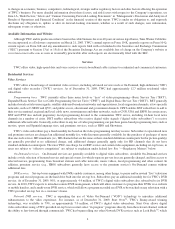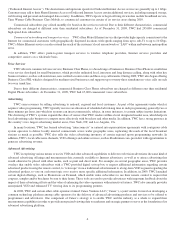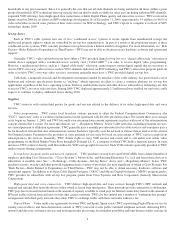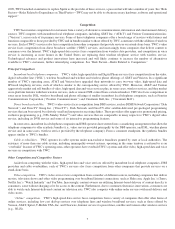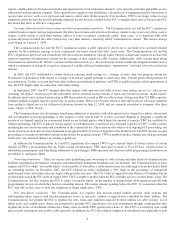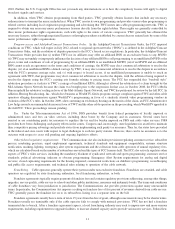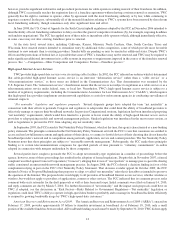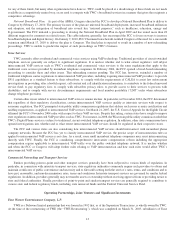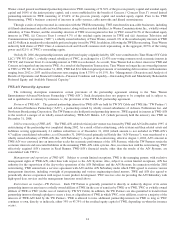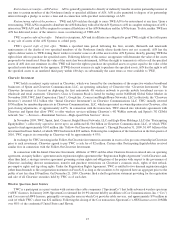Time Warner Cable 2009 Annual Report Download - page 17
Download and view the complete annual report
Please find page 17 of the 2009 Time Warner Cable annual report below. You can navigate through the pages in the report by either clicking on the pages listed below, or by using the keyword search tool below to find specific information within the annual report.
Marketing and Sales
TWC’s marketing focuses both on acquiring new customers as well as retaining and selling additional services to existing
customers. In both cases, offering attractive bundled services, particularly a triple play offering of video, high-speed data and voice
services, is a key element of TWC’s strategy. TWC offers bundled services to both its residential and commercial customers and,
increasingly, these customers subscribe to two or three of TWC’s primary services. TWC believes that bundled offerings increase its
customers’ satisfaction with TWC, increase customer retention and encourage subscription to additional features. Using a proprietary
system, TWC is able to segment existing and potential customers, and target its marketing efforts appropriately.
The following table presents selected statistical data regarding TWC’s customer relationships and double play and triple play
subscribers (in thousands):
2009 2008 2007
December 31,
Customer relationships
(a)
......................................................... 14,572 14,582 14,626
Double play
(b)
................................................................. 4,900 4,794 4,703
Double play penetration
(c)
........................................................ 33.6% 32.9% 32.1%
Triple play
(d)
.................................................................. 3,448 3,099 2,363
Triple play penetration
(e)
......................................................... 23.7% 21.2% 16.2%
(a)
Customer relationships represent the number of subscribers who receive at least one level of the Company’s primary services, encompassing video, high-speed data and
voice services (including circuit-switched telephone service, as applicable). For example, a subscriber who purchases only high-speed data service and no video service
will count as one customer relationship, and a subscriber who purchases both video and high-speed data services will also count as only one customer relationship.
(b)
Double play subscriber numbers reflect TWC customers who subscribe to two of TWC’s primary services.
(c)
Double play penetration represents double play subscribers as a percentage of customer relationships.
(d)
Triple play subscriber numbers reflect TWC customers who subscribe to all three of TWC’s primary services.
(e)
Triple play penetration represents triple play subscribers as a percentage of customer relationships.
TWC is in the fourth year of using the brand, The Power of You
TM
, to advertise a variety of features, such as Start Over, that
demonstrate that TWC customers are in control of their experience. This message is delivered via broadcast, TWC’s website, its cable
systems, print, radio and other outlets including outdoor advertising, direct mail, e-mail, on-line advertising, local grassroots efforts and
non-traditional media.
TWC also employs a wide range of direct channels to reach its customers, including outbound telemarketing, door-to-door sales,
online at www.timewarnercable.com and through third-party web partners, and in TWC and third-party retail stores. In addition, TWC
uses customer care channels and inbound call centers to sell additional services to existing customers, as well as new services to potential
customers.
Customer Care
During 2009, TWC made significant progress in improving its customer care processes and infrastructure. The Company’s customer
care strategy is designed to give customers more control over their experience in ways that are simple and easy and, to that end, is focused
on the reliability and technical quality of its plant, resolving customers’ issues on the first call, and providing customers several means of
communicating with the Company, including online approaches, such as eCare and MyService at www.timewarnercable.com.
Technology
Cable Systems
TWC’s cable systems employ a hybrid fiber coaxial cable, or “HFC,” network. TWC transmits signals on these systems via laser-fed
fiber optic cable from origination points known as “headends” and “hubs” to a group of distribution “nodes,” and uses coaxial cable to
deliver these signals from the individual nodes to the homes they serve. TWC pioneered this architecture and received an Emmy award in
1994 for its HFC development efforts. HFC architecture allows the delivery of two-way video and broadband transmissions, which is
essential to providing advanced video, high-speed data, voice, networking and transport services. As of December 31, 2009, virtually all
of the homes passed by TWC’s cable systems were served by two-way capable plant that had been upgraded to provide at least 750MHz
of capacity.
TWC believes that its network architecture is sufficiently flexible and extensible to support its current requirements. However, in
order for TWC to continue to innovate and deliver new services to its customers, as well as meet its competitive needs, TWC anticipates
that it will need to use the bandwidth available to its systems more efficiently over the next few years. To accommodate increasing
demands for greater capacity in its network, TWC has deployed a technology known as switched digital video (“SDV”). SDV technology
expands network capacity by transmitting only those digital and HD video channels that are being watched within a given grouping of
5






